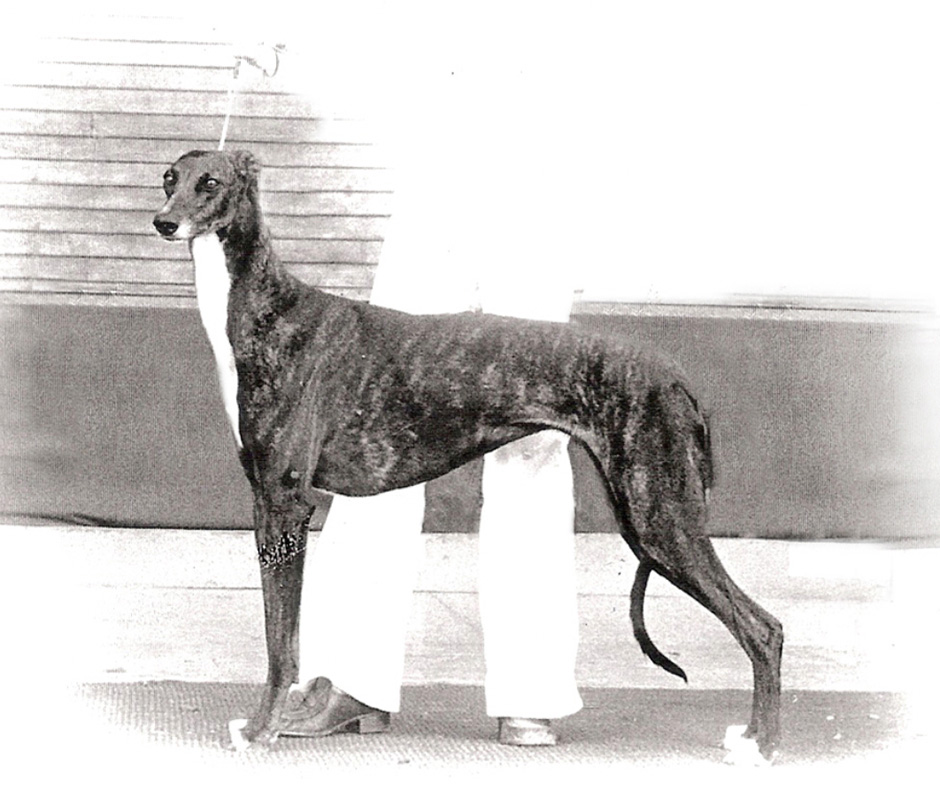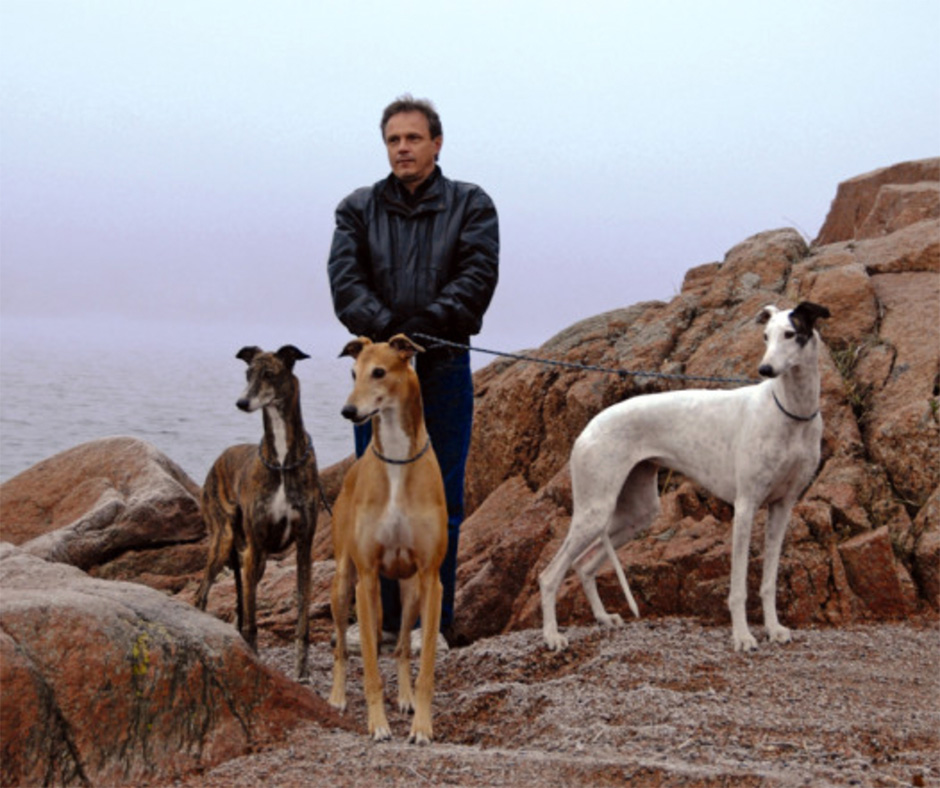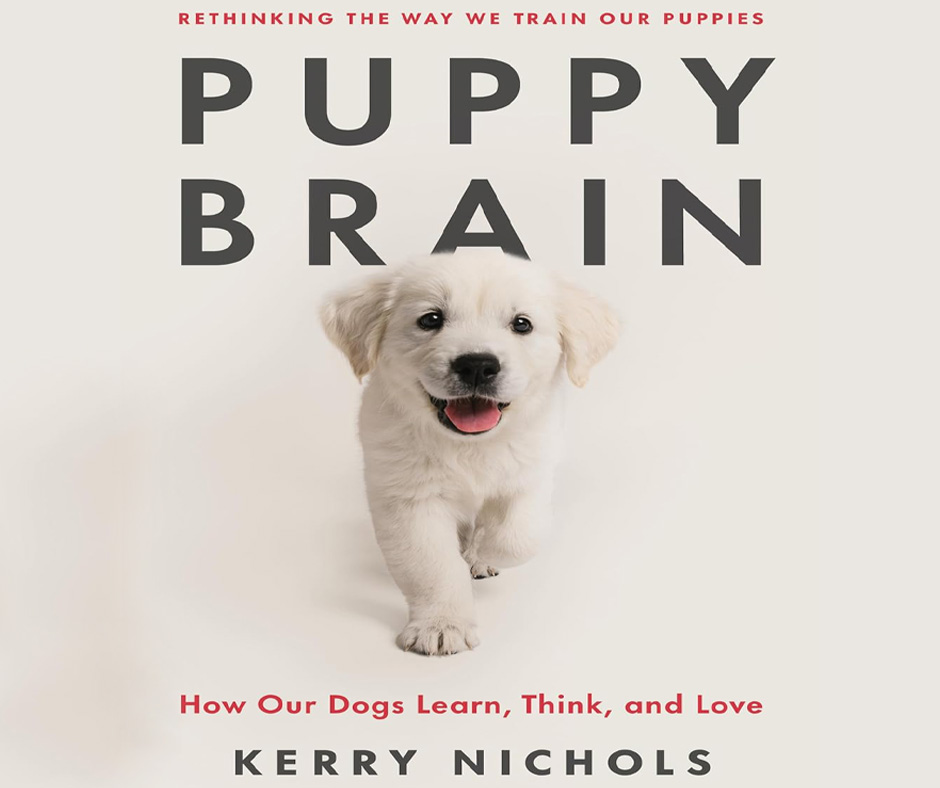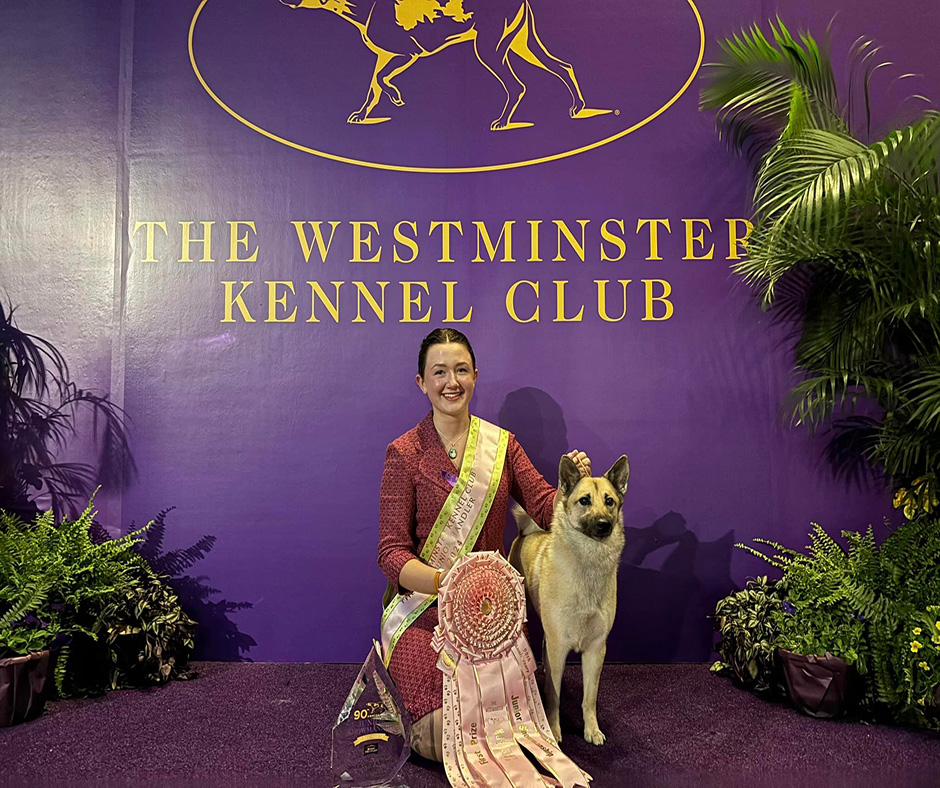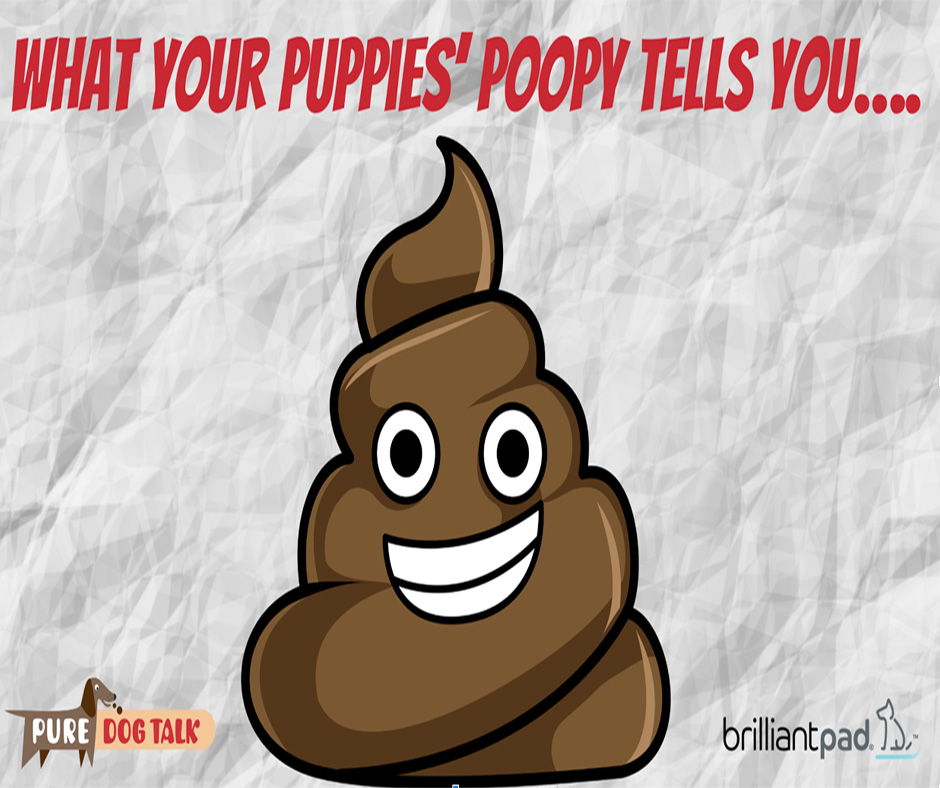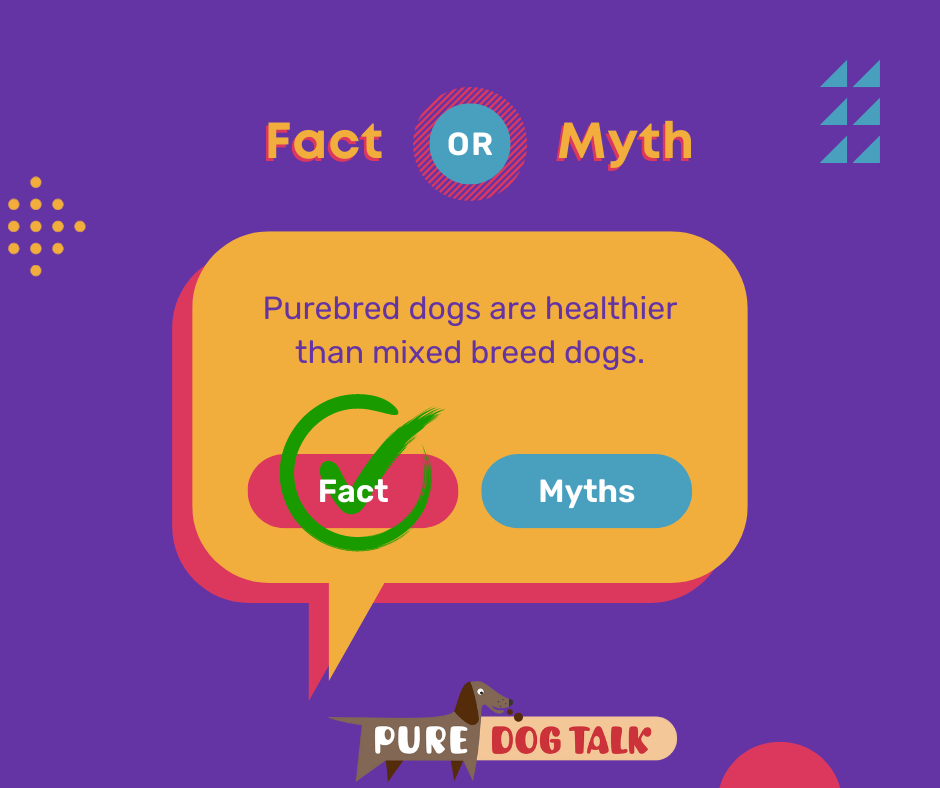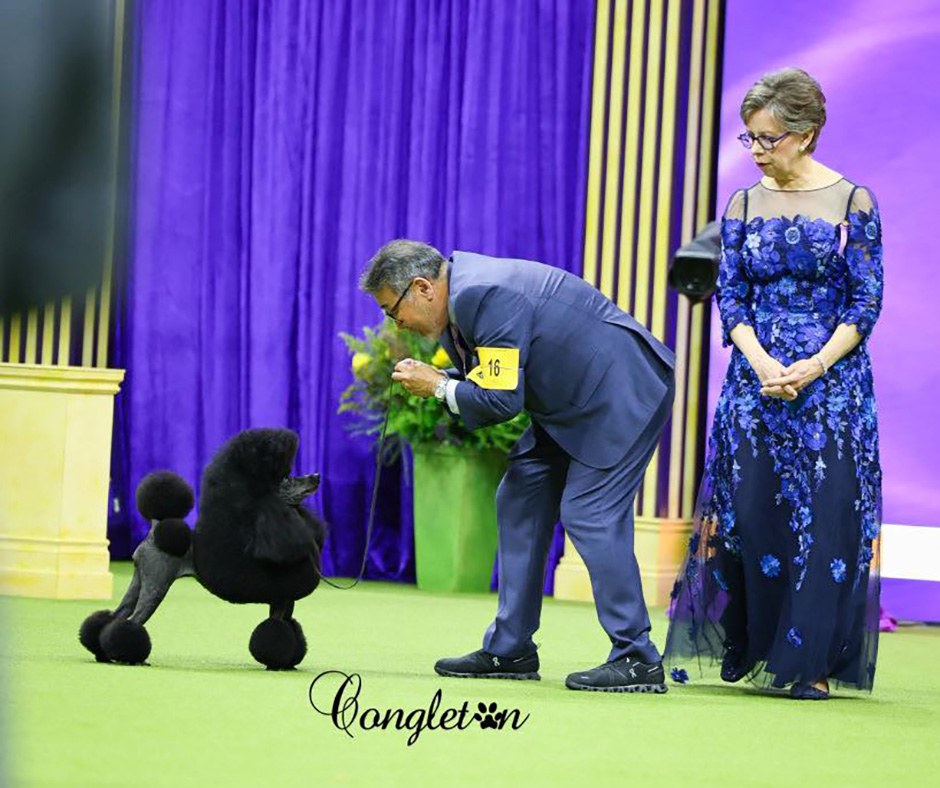643 — Bo Bengtson on Whippets and His Newest Book
Host Laura Reeves is joined by Bo Bengtson, legendary breeder, judge and author of The Whippet: An Authoritative Look at the Breed’s Past, Present and Future.
Questions for Bo:
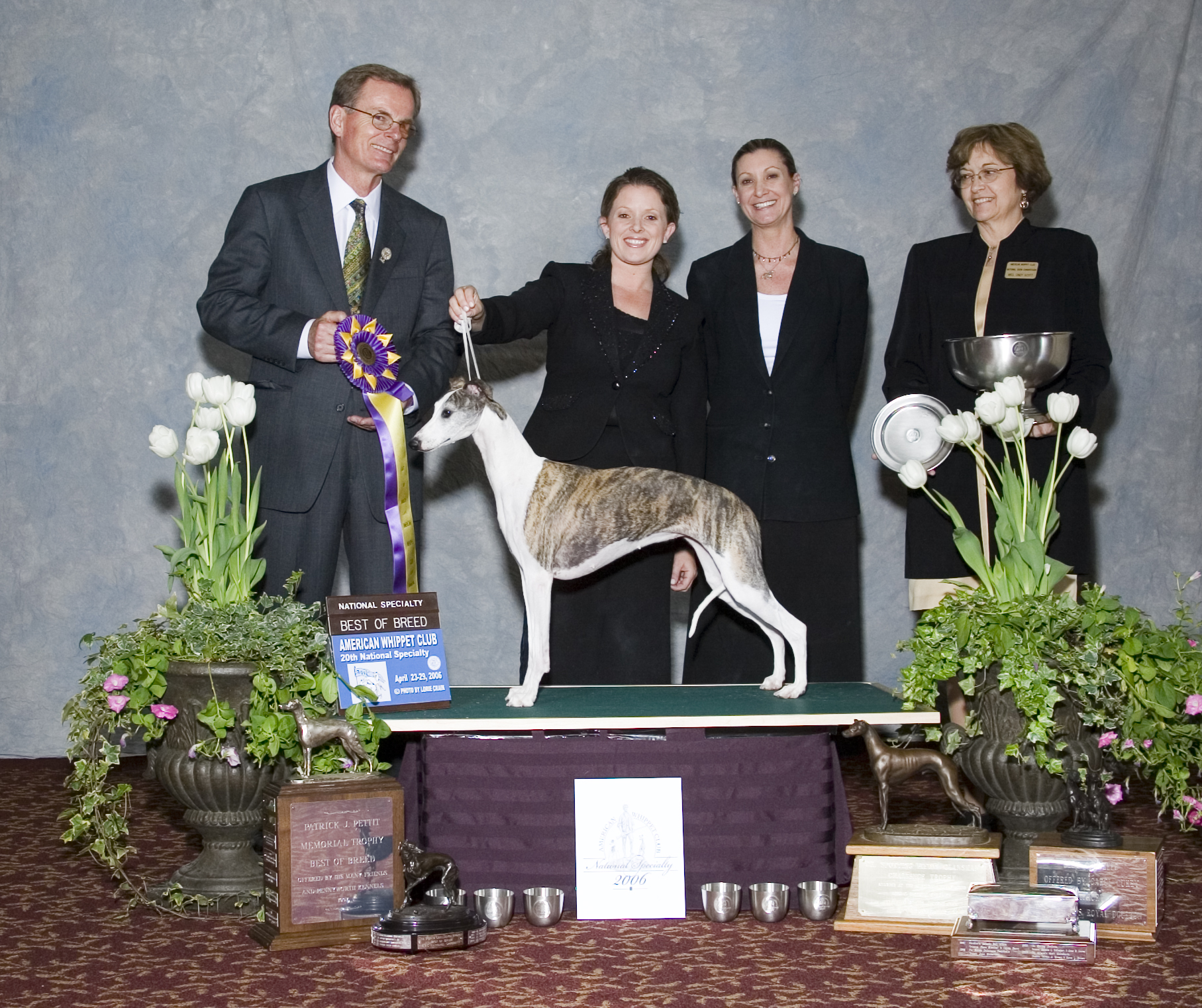
Bo Bengtson judging the American Whippet Club National Specialty.
1) This is your fourth edition of the quintessential book, “The Whippet,” first published in 1985. What made you want to update it again? What will readers find that is new?
I guess it’s pretty unusual for a dog book that was published that long ago to be reprinted, but it was last published in a much enlarged edition in 2010 and so much has happened in Whippets in the last 15 years! Whippets have become one of the most popular breeds at many shows: Crufts in England has had about 400 for the last few years, only Labs and Goldens have more… I have judged a show with 250 Whippets in Sweden, they have a Sighthound show in Germany that has 235 Whippets as a top figure, and it has become amazingly popular in many countries where you wouldn’t necessarily expect it: the big shows in e.g. Poland all have more than 100 exhibits NOW. The 2024 FCI World Dog Show was held in Croatia last month and there were 171 Whippets entered, which is fairly typical figure for the World Shows. And there are over 6,000 entries from the Czech Republic alone to the Internet’s Whippet Archive, so that’s probably the next big Whippet country!
USA doesn’t have the biggest registration figures, but the American Whippet Club holds a National Specialty in April every year that is the largest in the world, sometimes with more than 600 Whippets present and over 1,200 entries. I made a point of including all countries that have affected the world population in some way. Did you know that there is a world class Whippet breeder in South Korea that often wins in Europe and works with American bloodllines?
I read parts of that 1985 book recently … It’s not a bad little book for its time and a lot of the content is in later editions also, but it’s fairly typical of breed books then, both in scope and size. Not many photos and all black and white, but I’ll always remember how proud I was to get into Foyles Bookstore on Charing Cross Road in London and seeing my book on the shelf there!
To get back to the new book, I’m so grateful that Denise Flaim convinced me to update it! The book is available both on Amazon and via Denise’s RevodanaPublishing.com —they did a beautiful job: the book is much bigger than I expected — I don’t know why I didn’t expect that because I know that we added a lot of text and about 200 photos of winners from the last 15 years. Anyway, it weighs about 3.25 pounds, covers 530 pages, and when I took an advance copy to the National specialty in Tennessee in April, one reader actually started to cry because it was so beautiful!!
2) Share with our listeners some of the fascinating breed history you have gathered over the years, from its humble beginnings hunting hares, to its popularity as “the poor man’s greyhound,” to today.
Well, of course the Whippet became popularly known as the favorite dog of the poor mining families in the North of England in the 1800s. There was organized racing with considerable sums to the winners, so of course the dogs were really well taken care of and in fact fed much better than the people. What’s really amazing is how many people turned out to watch the races: there are some grainy black and white films still in existence from the late 1800s, and they prove beyond a doubt that there were thousands of spectators, many thousands.
But what I’ve found was that the Whippet had friends much higher up on the social ladder as well. Gertrude, the Lady Decies, was socially very prominent and owned several champion Whippets, including the two first brindle champions. She was primarily a cat fancier, breeder and exhibitor but she showed the dogs herself, in post-Victorian voluminous skirts and cartwheel hat. And there was also Sir Edmund Chaytor, Bart., who was a frequent exhibitor with Lady Chaytor and helped reorganize the Whippet Club after the first World War.
There are even some royal connections: in Kitty Kelly’s biography of the British royal family there is a previously unknown photo of Queen Mary with three of her sons, dating from perhaps 1910, which has a very good-looking Whippet in it: I have not been able to find out the name of the dog, but Queen Maud of Norway, who was born in England and granddaughter of Queen Victoria, was often photographed with her Whippets.
So I think that the Whippets has gotten a somewhat unfair rap for appealing only to one particular segment of society while in reality it was appealing both to high and low.
3) Talk about the Whippet internationally and the cooperation amongst breeders that has made it one of the deepest in quality globally.
There are differences between the standards in U.K. and in the U.S., but they are not greater than that a really good dog can win in both countries. The days when you almost needed an English Champion to win in the U.S. are long since gone, and the English added some American blood since then, which was quite successful, but mostly they import from Continental Europe these day – and Europe is full of fantastic Whippets of part English and part American breeding these days … The Europeans are almost more American than we are in the U.S. — and they LOVE American imports!
I must give shout-out to Italy, which has some wonderful Whippets and probably five or six word-class breeders, and Holland, who has a long history in the breed and currently houses Europe’s probably most successful stud dog, — who was born in South Africa of part British and part American background. The most successful breeder in England actually lives in Holland!
4) What other factors can you identify that account for the depth and breadth of quality in the breed?
I mentioned the Internet’s Whippet Breed Archive earlier; it has more than 372,500 pedigrees online — I just checked! — many of them illustrated. It’s an incredibly important tool for both novices and longtime fanciers like me, and everybody uses it. You can find statistics, both current and from the past, about things like population, color distribution, health, and the most popular sires, and you can even make up mock pedigrees for planned litters. I really think the success of the Whippet Breed Archive has been the success of the whole breed world-wide!
And there are so many different competitive outlets for Whippets, which probably accounts for much of the activity in the breed and explains why we lose so few new fanciers. You can focus on conformation, of course, but there are also field activities that you can participate in: racing or coursing, and we always have a couple of days of field activities during our national specialties, and sometimes there are the same dogs who participate. There were 200 entries in the coursing alone at the 2024 National, and 50 of them were conformation champions! And at the National Specialty there are invariably special classes for those who are racing or coursing qualified, and a special award to the winner of Best Performance Dog. Then you can of course participate in obedience or rally, like hundreds did at our last national specialty. And there are always well-filled Versatility and Triathlon classes!
5) What are Whippet breeders doing that the rest of the purebred dog fancy could learn from?
The fact that we have a really great, large and strong National Specialty is really important, I think. The Whippet people more or less take over a hotel or motel in a different part of the country in April every year, and beyond national specialty judging there is so much going on that there is no way you can participate in everything: there’s racing and coursing, Breeder’s Sweepstakes, Veteran’s Sweepstakes, Futurity, Top 20, health testing, judges education, parades of Honors and Rescues … and probably even more that I’ve forgotten, like obedience, agility and rally. … It gives people something to focus on; I’m really sorry for the breeds that don’t have a great National Specialty.
And it probably helps that we are as a group generally NICE! There are some exceptions, of course, but when I hear what goes on in some other breeds I am so grateful that I’m in Whippets! I doubt that anybody would refuse to let their stud dog be used on some bitches because they just happen to be owned by the “wrong” people, and if someone would like to buy a promising show puppy from another kennel, just let them. There is the usual grumbling about the wrong winners, of course, but I bet there’s less rancor and bad feelings in Whippets than in most breeds. We really try to be happy for each other when somebody is winning, even if it isn’t what we would have done if we were judging,
6) Can you identify and talk about three quintessential, iconic “lines” or families or kennels of Whippets, either standing alone or working together, that have most influenced the modern breed?
English Laguna: a son of the great stud dog Laguna Ligonier was sent over to the U.S. in the 1960s, Greenbrae Barn Dance, and basically created the American Whippet. He was an incredibly strong sire for his own elegant type, and his litter brother was exported to Canada: the sheer beauty of these dogs and their offspring was overwhelming; they were saved from an over-refined appearance by the strength of the Stoney Meadows more genuinely American line — bred by Mrs. Wear, Doris Wear.
And of course there was Peggy Newcombe and her Courtenay Fleetfoot of Pennyworth, who did wonderful PR for the breed by winning BIS at Westminster and being No. 1 dog of all breeds.
Later there was Ch. Delacreme De La Renta, who was a terrific sire, and his grandson Ch. Starline’s Reign On: both have sired well over 100 champions each, and Reign On is in the news again now for having sired many more champions in a couple of litters by A.I.
We are lucky to have so many clever breeders in pretty much all areas of the country, which makes it difficult to win with mediocrity anywhere. Sporting Fields has bred many litters, often in partnership with other breeders, but they have the number of champions for it, and six Sporting Fields dogs have won the National Specialty! Or seven if you count Ch. Bo-Bett’s Air Force One, who won in 2023 – he was officially co-bred by the late Carol Harris with Debbie Butt and her daughter Amanda Giles.
There are so many other kennels and stud dogs that have had breed-changing influence, like Starline and Chelsea and Plumcreek and Saxon Shore that it’s impossible to mention them all.
7) You have judged all over the world for decades. Name three dogs you have seen that you most admired and what made them stand out in your mind. Of the many beautiful Bohem whippets you’ve bred, which was your favorite?
Oh, that’s very difficult … Some of the dogs I’ve put up in Europe and Australia have been wonderful, but the best Whippet I’ve judged remains Ch. Brushwood’s Moxi of Endeavor in the U.S., who’s a perfect balance of elegance and strength. She should have won many more BIS than she did, but she won the AWC National three times, once under me.
I haven’t judged the Crufts BIS winner Ch. Pencloe Dutch Gold, who was wonderful and whom I got the opportunity to go over when he was shown not for competition when I judged a specialty in Scotland the same year he had won Crufts. He was so much more exciting than his pictures!
Nor have I judged GCh. Pinnacle Kentucky Bourbon, just admired her from ringside — I can still remember how enthusiastic some breeder-judges whom I really respect were about Bourbon when they had put her up at specialties before she was famous and had won more than a hundred BIS at all-breed shows.
By FAVORITES I have bred, I assume you mean by conformation? I haven’t bred a lot, but I must mention a dog I bred in Sweden long ago, Int. Ch. Bohem Mome Rath — most of the dogs we bred then don’t hold up today but he really does. Such a pity that I have nothing left of him; he was hardly used at stud at all and was owned by a teenage girl who was not easy to deal with and kept him way too fat! But she redeemed herself by later telling me how much she loved him when I had moved to the U.S., so that was OK.
The other dog that I’m really proud of is Ch. Bohem C’est la Vie, who had a short but brilliant career shown by my partner Paul Lepiane, who’s an excellent handler. He won both all-breed and specialty BIS with her but she remains famous mostly because she was lost at JFK Airport in the early 2000s and thousands of people spent months trying to find her until the NY Times declared her an “urban legend”… She was never found, but fortunately I had bred her young, and through her son she’s behind everything that came later.
ADDITONAL QUESTIONS (if there is time)
8) What other books have you written?
I wrote my first dog book when I was 22, so that’s a while ago — 58 years to be exact —and there have of course been a few books since then … I wrote a breed encyclopedia that I wasn’t particularly happy with, so I sold all the rights to it back to the publisher for not very much money … whereupon it was published in lots of languages and sold half a million copies! That would have been some nice royalties for me, but of course I got nothing and in fact only saw the book once after that — in a book-store window when I was judging in Brazil!
But I did write one other book that was good: it was called “Best in Show, The World of Show Dogs and Dog Shows” and was published in 2008, so it’s not exactly current. I worked on it for at least a couple of years and tried to make it as world-encompassing as possible and historically correct as possible. It has all the biggest winners of all the different breeds in the world in it and photos of most of them!
Dog shows had an early beginning in the 18th Century and descend one the one hand from shooting and hunting people and one the other hand from the rat catchers in the pubs of London: eventually these were considered offensive and gave rise to more humane activities, including clubs for “fancy dogs.”
But that book was never promoted as it should have been. It got wonderful reviews and won some awards, but I think the people who had worked on it with me were all fired, so nobody was left at the publisher who knew what it was about. I think it still is available on Amazon for about $20.
9) Why are you focusing so much on the past?
Well, because history is so fascinating, of course! I did’t think so when I was younger, and almost no younger person thinks so, so maybe you have to be kind of a historical artifact yourself to appreciate history? You can never know exactly what went on as recently as e.g. 100 years ago, because although people haven’t changed that much, in some respects people were different then — but you can read the remaining reports and guess what was meant by them.
I’m sure that many contemporary dog fanciers think that my fascination with the past is at least a little weird. Nobody can foresee the future, but as Churchill or someone said, “If you want to know about the future it helps to know the past …”
642 – Espen Engh Offers a Master Class on Dog Breeding
Espen Engh Offers a Master Class on Dog Breeding
Famed Norwegian Greyhound breeder and judge, Espen Engh, is back with host Laura Reeves offering a Master Class on dog breeding.
“When we started out, there was a combination of two very different British strains that had proven that it worked really worked,” Engh said. “Those two breeders were at the end of their career and they hadn’t mixed their dogs a lot while they were still active. But some very clever breeder very quickly found out that combining those two lines worked extremely well and produced dogs that had been almost unheard of before truly high quality.
“So we collected different crosses between those two lines to combine our own strain to start out with. And I do think it helped a lot that my mother had been active in the breed for 20 years before breeding the first litter. She had been judging for many years as well. We didn’t have to do a lot of the beginner’s mistakes. So from day one, we were able to start at a high note.
“When the breeder repeated (that successful breeding of two disparate lines) by luck or persistence, we were able to buy what we considered to be the best bitch in that repeat litter. And she turned out to be just as good as or probably better than those puppies from that first combination. So we were able to start with a really phenomenal bitch.
“We had a phenomenal male at the time too. He was runner up top dog all breeds in Norway. And maybe if we were amateurs, or if my mother was an amateur, we would have bred those two together, but they didn’t really fit. We would double up on faults. The male turned out not to be a good stud dog at all. And we had lots and lots of litters for other breeders. We never used him. So rather than using that top winning really beautiful dog, which didn’t fit the bitch, we didn’t do that from the start.
“So our first combination was quite successful and we got an outstanding bitch in that first combination. And then we quite quickly realized that in order to progress, you know, now we have like two generations of phenomenal bitches, we would never be able to be big breeders number wise. We didn’t have a big kennel, we didn’t have the style, the facilities to breed dogs on a large scale. So we had to make a system where you can actually breed successfully from a limited number of dogs.
“And I thought, why not just base it on breeding from the very best bitch of each generation? And that’s what we did. When we were at the most active, we would have three or preferably four litters from the very best bitch of each generation.
“As Greyhounds are very fertile, you’ll get an average of like 10 puppies or nine, 10, 11, 12 puppies. Each of those top bitches would then have 20 daughters to choose from. I mean, in every litter, we would keep all the bitches that were thought were good enough. Most of them never just one, two or three. And we’d run them on until they were fully grown so we would know for sure who was the best. And selected the best bitch of each generation and repeated that.
“Now, if the mother is great, the grandmother is great and the great -grandmother is great, you’re very likely to get the really good one out of 20 bitch puppies, aren’t you? But We also need some males to breed them to.
“We also chose the second-best bitch in the generation. Remember the mother had four litters, she would be bred to four different males. We selected the second-best bitch from each generation, preferably a half-sister to the main bitch, which I call the alpha bitch. So the second best bitch, the beta bitch, we would try outcrosses on her.”
641 – Espen Engh on Greyhounds and Judging
Espen Engh on Greyhounds and Judging
Host Laura Reeves is joined from Norway by famed breeder and judge Espen Engh of Jet’s Greyhounds for a two part conversation about Greyhounds, judging, breeding and why the Scandinavian dogs are so consistent in quality.

Int. Ch. Jet’s Elegant Negress, Engh’s first Best in Show winner from his first litter.
“I kind of inherited the interest for dogs in general and Greyhounds in particular because my mother started up with a Greyhound in 1955 so she was the source of everything,” Engh said. “She got her own mother hooked on the Greyhounds as well. So I’m a third generation Greyhound fancier and lover.
“My mother was only a teenager when she started out. She was very quickly bitten by the bug and started showing her first Greyhound all over Scandinavia. She didn’t breed, however, she didn’t have the possibility to do that. So my mother and I started breeding Greyhounds, 20 years after she got her first one, in 1975. And although my mother is no more with us, I keep reading from the same strain, actually from the same bitch line that was started in the early ‘70s.
“There are many things that make the Greyhounds unique. And one of them is their long, long, long history and the amount of generations that have gone into breeding greyhounds. I’m quite sure that the Greyhound is the only breed where you can actually trace the pedigrees back to the 1700s.
“(The first description of the Greyhound as having the “head of a snake, the neck of a drake”) is from a poem that was attributed to a woman called Juliana Burners more than 500 years ago.
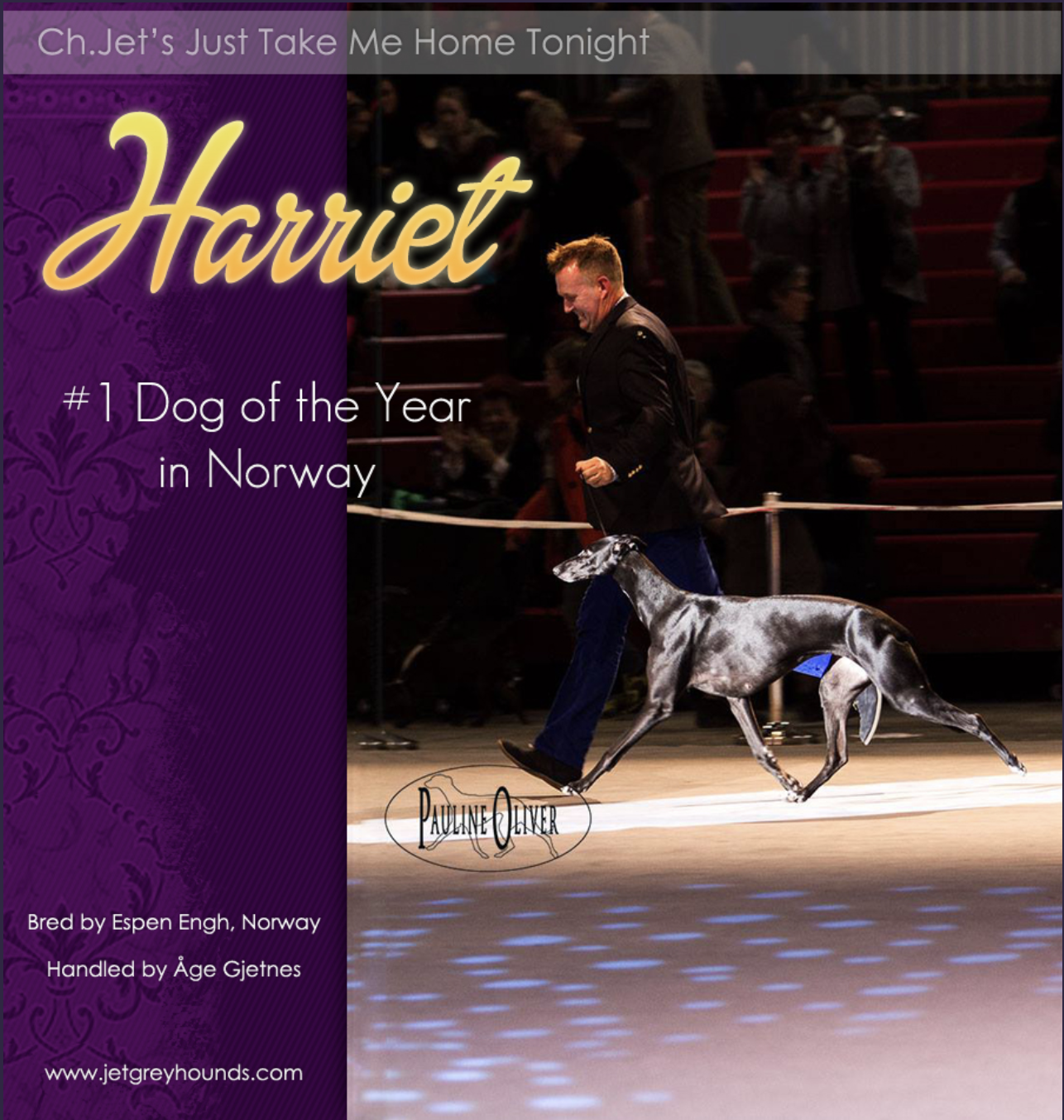
Ad for one of Engh’s multiple BIS winning Greyhounds.
Actually, she didn’t exist. So it’s somebody else wrote it. But that you could say is kind of the first Greyhound standard, because it describes the Greyhound, the head, the neck, the feet in a poem. Greyhounds are a very sophisticated breed. They are very close to their owners. They are about a combination of substance with elegance.”
Engh has been invited to judge at the highest levels worldwide.
“It certainly is a privilege. It’s certainly something very enjoyable to be able to travel around, somebody else picking up your bill, to enjoy looking at dogs, feasting your eye on dogs, getting that little tear in your eye every now and then, maybe a goose bumps every now and then too, which is really one of the reasons for doing it.
“But it does also present some challenges and some difficulties. Some breeds do have very different breed standards and that can certainly pose some difficulties. Other breeds, actually the breed standards themselves are not that different, but the development of the breeds are. So they have developed in quite different directions.
“Obviously, and I think we need to state that from the beginning, if you are willing and able and do undertake judging a breed in a foreign country, you have to respect the breed standard in that country. I mean, that should go without saying, but it doesn’t always.”
640 – Drinking from a Firehose: Puppy Enrichment Weeks 5 to 8
Drinking from a Firehose: Puppy Enrichment Weeks 5 to 8
Dr. Marty Greer joins host Laura Reeves for a continuation of their conversation about puppies and neonates. Puppies raised properly are given the best possible start to their future. Today’s topic is enrichment, all of the things that we can do in the five to eight week period between “their eyes are open, they’re eating solid food, they’re probably weaned or close to it” and go-home day.
Laura asks, “What’s happening in those little tiny puppy brains in that five to eight week period?”
Marty’s response is, “They’re taking in the world so fast, it’s like drinking from a fire hose.
“There’s a lot of people who talk about this and a lot of people who pontificate about it. I think Sophia Yin talked about a hundred experiences in a hundred days. That gives you basically three months to get all kinds of information into their little brains.
“Even when you don’t think you’re teaching your puppy something, you’re teaching your puppy something. And so I think we have to be ultra aware of even the things that we do when we have our back turned that if we’re making dinner or there’s a puppy jumping on the other puppy or there’s puppy going potty on the floor because they didn’t get our attention to take them outside. We just taught them something.
“You have to be ultra aware of everything you do. Not paying attention to them doesn’t mean that they’re not learning something. I think we really have to pay attention to that and there’s lots of really fun things we can do to teach them cool stuff, but be careful, because they’re learning every second.
“If they learn that they put their feet on the breadboard and pull something off (the counter), even if you weren’t looking, they just learned they can put their feet on the breadboard. And if it takes them 100 tries to get one thing the next time, it’s like winning the lottery.
“We think about our little tiny puppies and there’s all this stuff going on. They’ve got littermates, they’ve got other dogs in the house, they’ve got smells, they’ve got sounds, they’ve got all this stuff. You don’t want them to hear the ketchup bottle make that funny, squirty noise when it’s almost empty when they’re in their new home for the first time and it freaks them out.
“So you have to really think about all the input that we want to have for our dogs. How do we set them up for success? How do we provide them those things? So I do smell, I do touch, so I give different surfaces, we do different visual things, we do different toys, there’s different tastes, so there’s so much we can do.”
639 – Puppy Brain: How Our Dogs Learn, Think and Love
Puppy Brain: How Our Dogs Learn, Think and Love
Author Kerry Nichols joins host Laura Reeves for a review of her new book, “Puppy Brain: How Our Dogs Learn, Think and Love.”
Nichols’ book is written for the dog buying public to help them understand how to find a breeder, what a responsible breeder looks like, how puppies learn, and how breeders and buyers can work together to raise well-adjusted dogs.
“We all know you have to prepare your families,” Nichols said. “Like the more prepared your families are the better your puppies’ lives will be. So from litter number one, I started to joke around ‘hey, you know you’re enrolling in Nicholberry boot camp. If you’re not ready to read and watch and listen I’m not the breeder for you, because I really want you to be ready.
“That actually evolved into requiring that our families take a training course, you know, I really want them to be prepared because we’ve all seen it go badly when they’re not and you send home this lovely puppy who very quickly gets into trouble and that’s heart -wrenching to see.
“I had this whole backlog of a private blog that I was keeping for our families and basically they needed to read a pretty hefty article or watch a video every day for the eight weeks that their puppy was growing.”
As a content creator, Nichols has proven suggestions for breeders also about how to grow their educational social media outreach about their breed and their breeding programs.
- It’s a marathon not a sprint … don’t think that you’re going to post 10, 50, 100 posts and you’re going to get this following. It is consistency, consistency, consistency.
- Authenticity, which is why I think it doesn’t work to hire a social media manager.I’ve had arguments with people on this topic, but there’s no way I could have never hired anybody to do what I do because, it’s all in my DMs. I’m responding, it’s in my comments, I’m interacting. And that’s fantastic because the questions will inform your content.
- I think it’s super important that breeders allow people to see what they’re actually doing on a daily basis.Yesterday, someone asked me to vet a breeder for them of a different breed, and I went on the website and it said that they followed puppy culture protocols. And they have a big following on Instagram, but I couldn’t find a single video that demonstrated puppy culture protocols.So that’s fine to say it, but I don’t just trust that they’re doing it. I want to see them doing a barrier challenge, right? So I’d say that, show what you’re actually doing.
638 – Juniors’ Best Advice: Always Strive to Improve
Juniors’ Best Advice: Always Strive to Improve
Octavia Stensen, Best Junior at Westminster Kennel Club this year, joins host Laura Reeves for the behind the scenes story of how a non-dog show kid just capped off the triple crown of junior showmanship, having also won Best Junior at the AKC National Championship and made finals in Juniors at Crufts.
Stensen’s family acquired a Norwegian Buhund when she was 10 years old. Her first time in the ring left her in tears, but she persevered and nine years later she reached the pinnacle of the sport for juniors.
“We ended up getting Fiona and she became our new pet but the one catch of it was that we had to get her grand champion,” Stensen said. “I was like, ‘I’ll do it. I don’t even know what that means but I will do it. I don’t even know what this entails or what I’m doing in this, but I am going to do it.’ And so it started from there and it wasn’t easy by any means.
“I went to bed that night (after my first ring experience) thinking, I can do better and I can do better here and I could have done this and I’m gonna do that next time,” Stensen said. “And there was a next time, you know what I mean? There was like that idea of the future.
“I did eventually get her Grand and she is now our pet and we have since then bred her and got my heart dog out of that, Pineapple.

Octavia Stensen with her mom and Pineapple after the WKC Best Junior win.
“I am so, so lucky both my mom and my dad have been so supportive, but my mom really steps up. My dad is like, I’ll pay the bills, but my mom is like, I’m going to be here next to you and I’m going to travel with you to all of these things and I couldn’t be more grateful for that.
“They have definitely supported me in more ways than I could have ever, ever asked for. I mean, after winning at Orlando and walking out of the ring and then being like, so I guess I need to go to London now. And they were like, ‘okay, so let’s figure out how we’re going to finance that.’
Stensen’s advice to juniors coming up is always have fun and never stop improving.
“It is so, so hard to get caught up in the competition and freaking yourself out and getting all nervous but this is meant to be fun. It’s all for fun. We are coming to these things to have a good time, we’re not coming to these things to torture ourselves with nerves. Listen to your mentors and your peers and you can always be better. You can consistently improve. I mean, there’s never a moment in your life where you can stop getting better at things.”
637 – What Your Puppies’ Poopy Tells You
What Your Puppies’ Poopy Tells You
Dr. Marty Greer, DVM joins host Laura Reeves for an extended conversation about puppy poopy. Color, consistency, contents and coating of the puppy’s stool give detailed information about its gut health. They also discuss prevention and treatment of common intestinal upset.
“A yellow, softened, seedy stool is absolutely normal (for the first two weeks),” Greer said. “It’s not that they’ve eaten anything that shouldn’t be in there. That’s just normal milk curd being digested and the normal color with the digestive enzymes.”
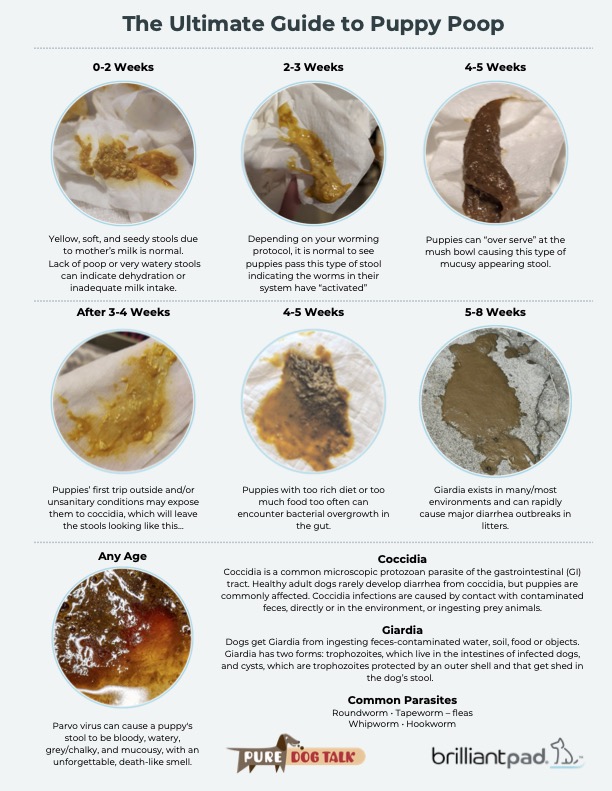
Puppy stool samples and what they tell you, at a glance.
To watch the entire presentation, with photos, click the link HERE.
Intestinal parasites
“If a bitch ever had roundworms when she was a puppy or ever had hookworms when she was a puppy, those will encyst in her muscles and they will reactivate during the stress of pregnancy and lactation and migrate,” Greer said.
“Roundworms migrate through the placenta into the puppies. So, this is how puppies are born with intestinal parasites, is they’re already born with them before they are hatched, they come out, and hookworms will migrate through the milk and into the puppies.
“So this is how we end up with parasites that are going to cause problems in puppies. And they typically will start to become an issue when the puppies are right about three weeks of age. So just three to four weeks, just about the time you’re starting to wean, about the time you’re trying to get them on to solid food, they get sick, they feel puny, they have a belly ache, they don’t feel good, you end up going to the vet.
“Sometimes those stool samples are negative even if the parasites are there because the parasites need to be at least three weeks old to produce the eggs that it takes for them to see under the microscope.”
Worming pregnant dams with Fenbendazole (Pancur) is the only guaranteed way to raised puppies not born with intestinal parasites.
“So Panacur, you start at day 42 of the pregnancy,” Greer said. “And you give the dewormer every single day from day 42 of the pregnancy until the puppies are 14 days old. That is five weeks. The label says three days, and I understand the label says three days, but it is a five -week protocol. It is an off -label use, technically, but I can say that because I’m a veterinarian and I’m allowed to say those things. This protocol was published for the first time in the early 1980s.
“We’re giving 50 milligrams per kilogram once a day (to the dam for five weeks). If you give the suspension, not the tube paste, but the suspension, the liquid stuff that you shake up. That’s given at one cc per four pounds of body weight. Safeguard, Panacur, fenbendazole is all the same thing. So if it’s a 10 % solution, it’s one cc per four pounds of body weight. Or you can use the granules. Now granules come in little packages, but they also come in a one pound tub, so there are very cost effective ways for you to get this. I’ll tell you the bitches don’t like the medication given daily, but you know what? I don’t like worms in my washing machine and in my puppies, so I’m going with, I’d rather deworm the bitch.”
636 – Study Shows Purebred Dogs Healthier Overall than Mixed Breeds
Study Shows Purebred Dogs Healthier Overall than Mixed Breeds
Dr. Kiersten Forsyth, DVM cardiology resident at Purdue and lead author of the recent paper from the Dog Aging Project discussing findings on health in our canine companions, joins host Laura Reeves with the details, which are not necessarily the same as what you might have heard.
“The Dog Aging Project is this really cool community science project,” Forsyth said. “Essentially, there are some researchers that are involved at a few different universities, but the main people that are involved in this project are the dog owners themselves. People can nominate their dog to participate.
“It is a longitudinal observational study, which basically means as a pet owner, once a year you fill out this really big survey that tells all about your dog, what their history is as far as their health, but also where they live, what kinds of things they do, the environment they’re in. And that information for one dog might not tell us a lot, but when we have tens of thousands of dogs participating, we can pull a lot of information from this.
“And so once a year, you get to refill out this survey, and we can follow these dogs throughout their lifetime to see what changes, what they’re exposed to and our real goal is to learn more about all of these dogs in the U.S., but also what makes some dogs live longer than other dogs and can we get more information about aging in these dogs?
“For the specific research part that I was involved in, we were looking at all of the dogs who were enrolled in the study during the year of 2020. We had 27,541 dogs included. So, a huge number.
“Of those, about 50 percent of them were mixed breed dogs and 50 percent of them were purebred dogs. We tried to look at what the 25 most common or popular dog breeds were that made up the dog aging project pack at that point in time and then really focused on those top 25 breeds to then say, ‘okay for these specific breeds, what are the most common medical conditions that their owners are reporting their dog to have experienced in their lifetime’.
“So, for each breed, we came up with a list of their 10 most commonly reported conditions, and then we looked to compare how those changed between different breeds and between the mixed breed population and the purebred population to see is there really a difference in the amount of medical conditions that a dog gets if they’re a purebred dog versus being a mixed breed dog.
“When we looked at it, one of the things we were wondering was, do purebred dogs have more disease than mixed breed dogs? And we found, no, that’s not the case. In fact, it might even be slightly suggested into the opposite, ’cause we looked at, of all of these dogs, how many of them did not have any health conditions reported?
“These are our healthy dogs. Nothing has been reported to be wrong with them. And we found that 22 percent of the purebred dogs had no reported medical conditions. And just under 21 percent of the mixed breed dogs had no medical conditions. So, there was really a 1.6 percent difference between the two of them, which is not a huge difference, but it was actually statistically significant that the purebred dogs were actually more likely to have no owner-reported medical conditions than our mixed breed dogs.
“It’s really not more likely to have disease in your purebred dogs.
“Now, specific breeds may be more likely to have specific conditions. And that goes along with, you know, I do a lot of stuff with the heart. I know that if we think of degenerative valve disease, Cavaliers come to the top of your mind, or if you think of dilated cardiomyopathy, Dobermans come to the top of your mind. And we’re not saying that certain breeds aren’t more prone to very specific diseases or medical conditions, but as a whole, being purebred doesn’t show a higher reporting of medical conditions compared to mixed breed.
“It’s turning out that common things happened commonly, where even though we’re looking at these purebred dogs, where you might think they’re prone to very specific diseases or medical conditions, it still is things like dental disease, dog bites from other dogs. Those are still some of the things that are showing up frequently across breeds, not just with one specific breed.”
635 – NOHS Regional Events from the Club’s Perspective
NOHS Regional Events from the Club’s Perspective
Ryan Horvath and Sandra Pretari Hickson join host Laura Reeves to discuss the upcoming first ever NOHS Regional Event at their Harvest Moon Classic dog shows Oct. 17-20 this year.
“Since the inception of the owner handled competition, we’ve included it in our shows every year,” Horvath said. “And we’ve also recognized the need to elevate it to a status on par with the rest of the show. So, we’ve offered similar trophies. We have the event taking place right in the main hall with the rest of the show so that you can kind of go pick and choose what you want to watch, who you want to cheer for, you know, and make sure that you can make all your ring times because, you know, it can get a little hairy sometimes.”
“(NOHS Regional) is happening on Saturday,” Pretari Hickson said, “on the same day as the regular dog show, but it is a standalone event. So we’re not offering the traditional owner handled that day.
And we have rings dedicated to just owner handlers. And we actually have brought in judges just for this.”
“It’s challenging being one of the first clubs to put this on,” Horvath added. “Trying to invent it from the ground up. And we are in a new site that we’ve had two years in and we continue to evolve and develop new things that we need to improve each year. So this is one more thing that we have to integrate in and kind of start out without anyone to look at and see how they do it.
“One of the things that we try to pay attention to, and something we’ve definitely done for this regional event, is to have judges that are approved for these groups. And so you’re gonna have judges who, judge them, know the breeds, and many times we’ve had them on our panels doing similar breeds and groups in the past. So, we’re thrilled to be able to provide them with an equal stake.”
634 – Best Advice from Best in Show Judge, Roz Kramer
Best Advice from Best in Show Judge, Roz Kramer
Roz Kramer, Best in Show judge for Westminster Kennel Club last week, joins host Laura Reeves with advice, stories, suggestions and tips for all exhibitors.
On judging Best in Show at Westminster
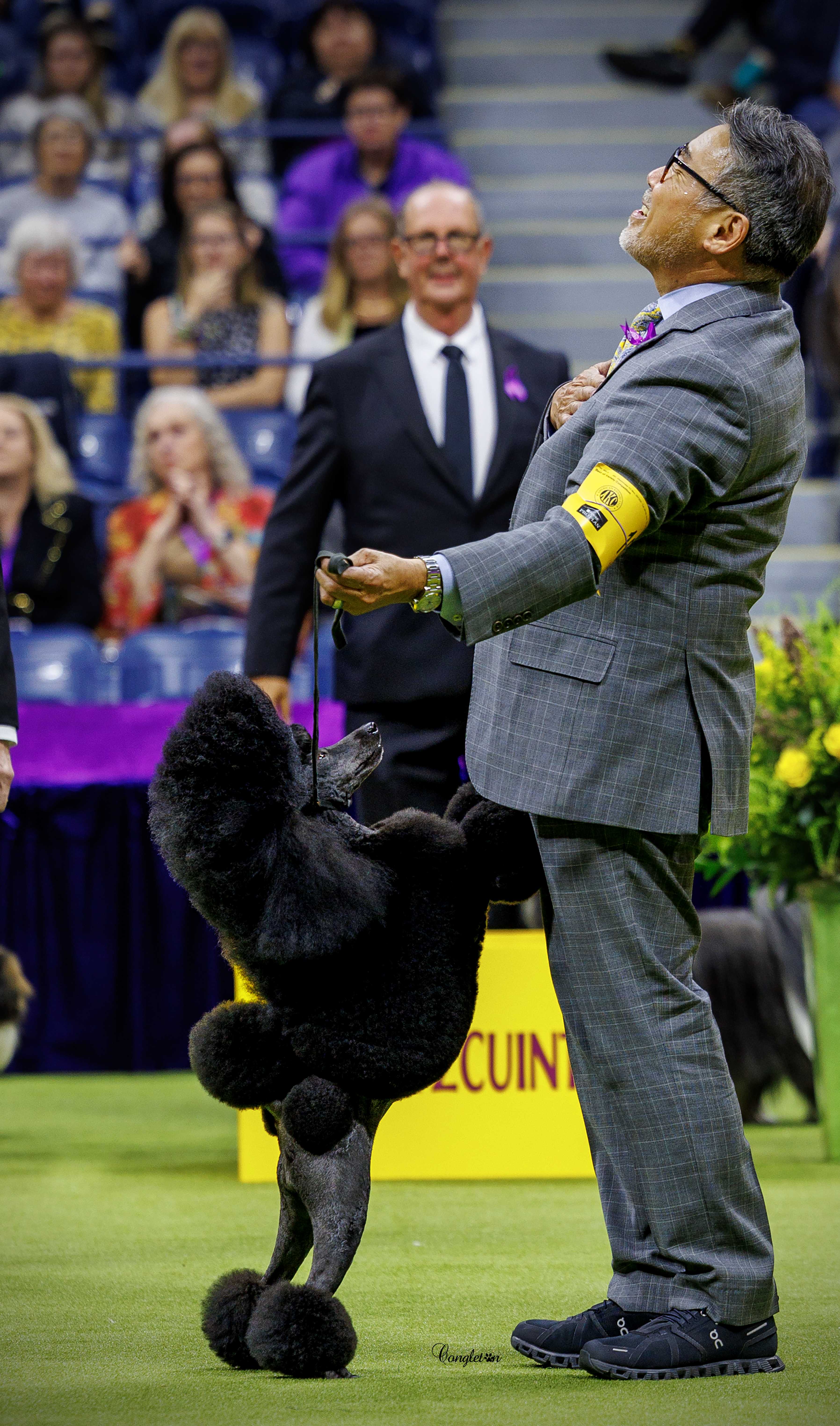
Kaz Hosaka, winning BIS at WKC with the Miniature Poodle, Sage.
“You know, you’re sequestered and so you don’t really know who you’re getting and they come in the ring one at a time and it was one gorgeous dog after another.
“I mean, all of them showed like a million bucks. They all looked wonderful, fabulous condition. And it gave me goosebumps. It really did. I was so happy and so thrilled.
On her mentors
“I have had three incredible mentors for me Annie (Rogers Clark), Janey and Bob (Forsyth). I had so much respect for the three of them. Annie, she was such a teacher in many ways. I never worked for any of them, but you saw them at shows all the time and they’d give you little hints or little suggestions all the time and or you’d just sit and listen to them and you’d learn.
On how newer exhibitors can succeed
“You should stick around (after showing in the ring), learn your history of your breed, learn who the greats of the breed were, learn your pedigrees, figure out who the best multiple breeders of your breed, and it wouldn’t matter if they’re ones on the west coast and ones in Texas and ones in Maine. Seek those people out, learn the best you can. And then if you get a dog, don’t be afraid to go, not just ask other breeders for help on trimming or showing.
“I’m telling you, you go to most of these handlers, it doesn’t matter who they are, they are more than willing to help. We need the new people in the sport and everybody knows it and I think that what people also need to do is don’t think that you’re better than everybody else, be kind and caring to people because you know something, we all have to ask for help at some point in our lives and don’t be afraid to.
“You know one of the ways that I learned when I was a kid is my mentor on the Scotty’s John Sheehan. He’d trim the show side and then he’d say ‘okay now you trim the other side. Copy that.’
“(There) is the conditioning part. And it was a teaching tool to me that you do this day after day, hour after hour, and don’t stop. And it’s going to pay off.
“It’s artistry, and I think people prefer the quick fix and the easy fix. I think that people should give themselves a challenge, prove what they can accomplish and they might be surprised.”
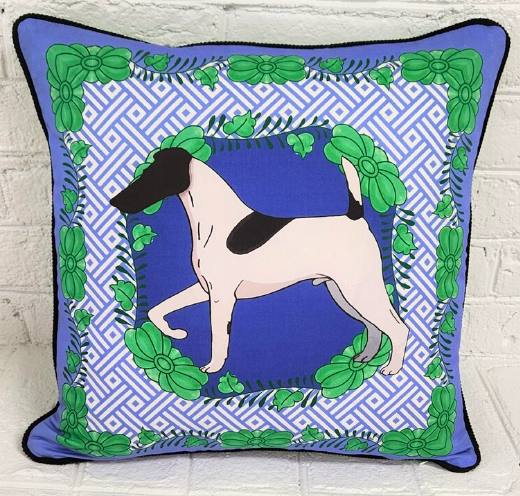
Kramer’s Etsy shop features home decor and fashion items like this pillow cover.
Visit Kramer’s Etsy shop to see her beautiful breed specific designs on home decor and fashion items.


